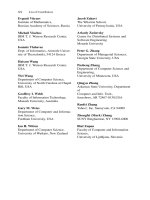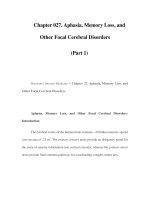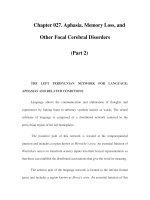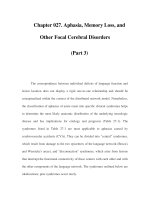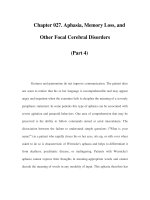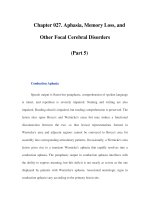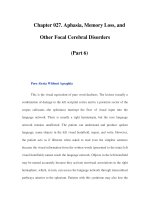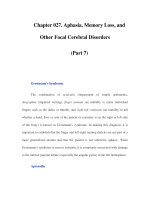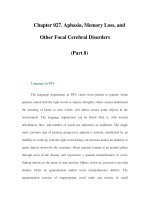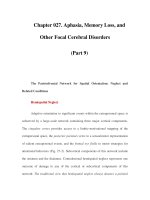Chapter 031. Pharyngitis, Sinusitis, Otitis, and Other Upper Respiratory Tract Infections (Part 3) ppt
Bạn đang xem bản rút gọn của tài liệu. Xem và tải ngay bản đầy đủ của tài liệu tại đây (23.06 KB, 8 trang )
Chapter 031. Pharyngitis, Sinusitis, Otitis, and Other
Upper Respiratory Tract Infections
(Part 3)
Clinical Manifestations
Most cases of acute sinusitis present after or in conjunction with a viral
URI, and it can be difficult to discriminate the clinical features of one from the
other. A large proportion of patients with colds have sinus inflammation, although
bacterial sinusitis complicates only 0.2–2% of these viral infections. Common
presenting symptoms of sinusitis include nasal drainage and congestion, facial
pain or pressure, and headache. Thick, purulent or discolored nasal discharge is
often thought to indicate bacterial sinusitis but also occurs early in viral infections
such as the common cold and is not specific to bacterial infection. Other
nonspecific manifestations include cough, sneezing, and fever. Tooth pain, most
often involving the upper molars, is associated with bacterial sinusitis, as is
halitosis.
In acute sinusitis, sinus pain or pressure often localizes to the involved
sinus (particularly the maxillary sinus) and can be worse when the patient bends
over or is supine. Although rare, manifestations of advanced sphenoid or ethmoid
sinus infection can be profound, including severe frontal or retroorbital pain
radiating to the occiput, thrombosis of the cavernous sinus, and signs of orbital
cellulitis. Acute focal sinusitis is uncommon but should be considered in the
patient with severe symptoms over the maxillary sinus and fever, regardless of
illness duration. Similarly, advanced frontal sinusitis can present with a condition
known as Pott's puffy tumor, with soft tissue swelling and pitting edema over the
frontal bone from a communicating subperiosteal abscess. Life-threatening
complications include meningitis, epidural abscess, and cerebral abscess.
Patients with acute fungal sinusitis (such as mucormycosis) often present
with symptoms related to pressure effects, particularly when the infection has
spread to the orbits and cavernous sinus. Signs such as orbital swelling and
cellulitis, proptosis, ptosis, and decreased extraocular movement are common, as
is retroorbital or periorbital pain. Nasopharyngeal ulcerations, epistaxis, and
headaches are also frequent, and involvement of cranial nerves V and VII has been
described in more advanced cases. Bony erosion may be evident on examination.
Oftentimes, the patient does not appear seriously ill despite the rapidly progressive
nature of these infections.
Patients with acute nosocomial sinusitis are often critically ill and thus do
not manifest the typical clinical features of sinus disease. This diagnosis should be
suspected, however, when hospitalized patients who have appropriate risk factors
(e.g., nasotracheal intubation) develop fever of unknown origin.
Diagnosis
Distinguishing viral from bacterial sinusitis in the ambulatory setting is
usually difficult, given the relatively low sensitivity and specificity of the common
clinical features. One clinical feature that has been used to help guide diagnostic
and therapeutic decision-making is illness duration. Because acute bacterial
sinusitis is uncommon in patients whose symptoms have lasted <7 days, several
authorities now recommend reserving this diagnosis for patients with "persistent"
symptoms (i.e., symptoms lasting >7 days in adults or >10–14 days in children)
accompanied by purulent nasal discharge (Table 31-1). Even among the patients
who meet these criteria, only 40–50% have true bacterial sinusitis. The use of CT
or sinus radiography is not recommended for routine cases, particularly early in
the course of illness (i.e., at <7 days), given the high prevalence of similar
abnormalities among cases of acute viral rhinosinusitis. In the evaluation of
persistent, recurrent, or chronic sinusitis, CT of the sinuses is the radiographic
study of choice.
Table 31-1 Guidelines for the Diagnosis and Treatment of Acute
Sinusitis
Age
Group
Diagnostic
Criteria
Treatment Recommendations
a
Moderate
symptoms (e.g., nasal
purulence/ congestion or
cough) for >7 d or
Initial therapy
Severe sym
ptoms
of any duration, including
unilateral/focal facial
swelling or tooth pain
Amoxicillin, 500 mg PO tid or
875 mg PO bid, or
TMP-
SMX, 1 DS tablet PO bid
for 10–14 d
Adults
Exposure to antibiotics within 30
d or >30% prevalence of penicillin-
resistant S. pneumoniae
Amoxicillin, 1000 mg PO tid,
or
Amoxicillin/clavulanate
(extended release), 2000 mg PO bid, or
Antipneumococcal
fluoroquinolone (e.g., levofloxacin, 500
mg PO qd)
Recent treatment failure
Amoxicillin/clavulanate
(extended release), 2000 mg PO bid, or
Amoxicillin, 1500 mg bid, plus
clindamycin, 300 mg PO qid, or
Antipneumococcal
fluoroquinolone (e.g., levofloxacin, 500
mg PO qd)
Moderate
symptoms (e.g., nasal
purulence/congestion or
cough) for >10–14 d or
Initial therapy
Severe symptoms
of any duration, including
fever (>102°F),
unilateral/focal facial
swelling or pain
Amoxicillin, 45–
90 mg/kg qd
(up to 2 g) PO in divided doses (bid or
tid), or
Cefuroxime axetil, 30 mg/kg
qd PO in divided doses (bid), or
Cefdinir, 14 mg/kg PO qd
Children
Exposure to antibiotics within 30
d, recent treatment failure, or >30%
prevalence of penicillin
-
resistant S.
pneumoniae
Amoxicillin, 90 mg/kg qd (up
to 2 g) PO in divided doses (bid), plus
clavu
lanate, 6.4 mg/kg qd PO in
divided doses (bid) (extra-
strength
suspension), or
Cefuroxime axetil, 30 mg/kg
qd PO in divided doses (bid), or
Cefdinir, 14 mg/kg PO qd
a
Unless otherwise specified, the duration of therapy is generally 10 d, with
appropriate follow-up.
Note: DS, double-strength; TMP-SMX, trimethoprim-sulfamethoxazole.
Sources: American Academy of Pediatrics Subcommittee on Management
of Sinusitis and Committee on Quality Improvement, 2001; Hickner et al, 2001;
Piccirillo, 2004; and Sinus and Allergy Health Partnership, 2004.
The clinical history and/or setting can often identify cases of acute
anaerobic bacterial sinusitis, acute fungal sinusitis, or sinusitis from noninfectious
causes (e.g., allergic rhinosinusitis). In the case of an immunocompromised patient
with acute fungal sinus infection, immediate examination by an otolaryngologist is
required. Biopsy specimens from involved areas should be examined by a
pathologist for evidence of fungal hyphal elements and tissue invasion. Cases of
suspected acute nosocomial sinusitis should be confirmed by sinus CT. Because
therapy should target the offending organism, a sinus aspirate should be obtained,
if possible, for culture and susceptibility testing.
